Welcome to our comprehensive flea and tick prevention guide for Illinois pet owners. Fleas and ticks are year-round pests. But as warmer weather approaches, so does the increased risk of fleas and ticks, which thrive in our state’s diverse landscape. No matter if you’re new to pet ownership or a seasoned pet owner, it’s important to grasp the unique challenges and effective prevention strategies to ensure your furry friends stay happy and healthy. In this blog, we’ll cover the risks posed by fleas and ticks and provide expert advice on protecting your beloved pets from these pesky parasites.
Understanding Fleas and Ticks
Fleas and ticks are external parasites that feed on the blood of animals, including dogs, cats, and even humans.
Life Cycle of Fleas
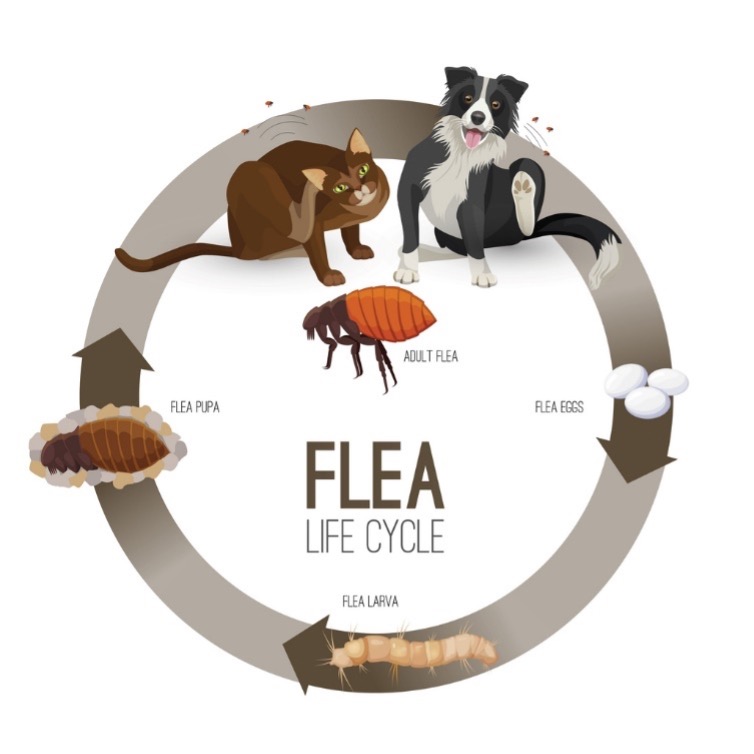
Fleas go through four stages: egg, larva, pupa, and adult. The eggs are laid on the host animal but quickly fall off and can be found in carpets, bedding, cracks in the flooring, and furniture. The larvae hatch from the eggs and feed on organic matter, such as flea feces and skin debris. They eventually spin a cocoon and emerge as adults, ready to jump onto a new host.
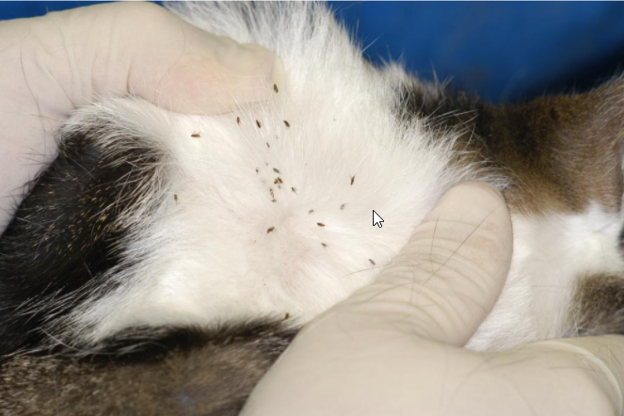
Photo of a pet infested with fleas
Life Cycle of Ticks
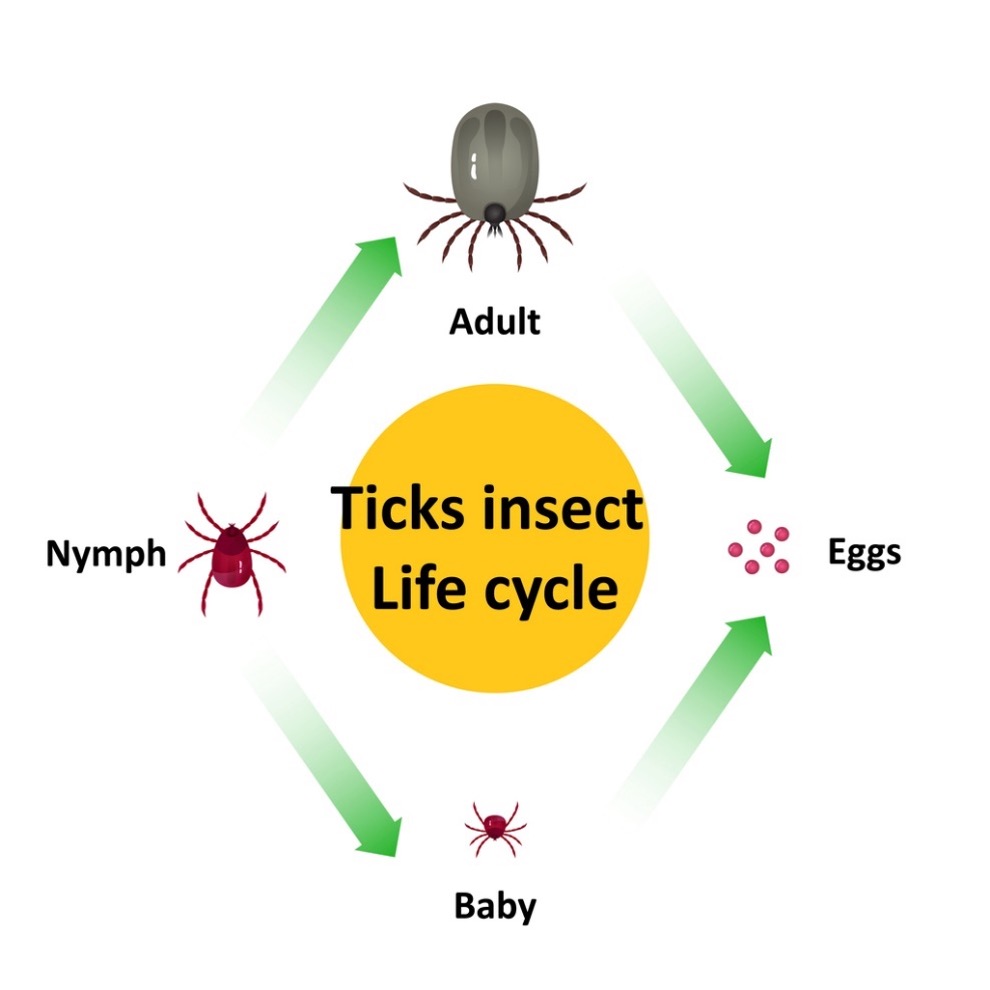
The life cycle of a tick also consists of four stages: egg, larva, nymph, and adult, with each stage requiring a blood meal from a host to progress to the next.
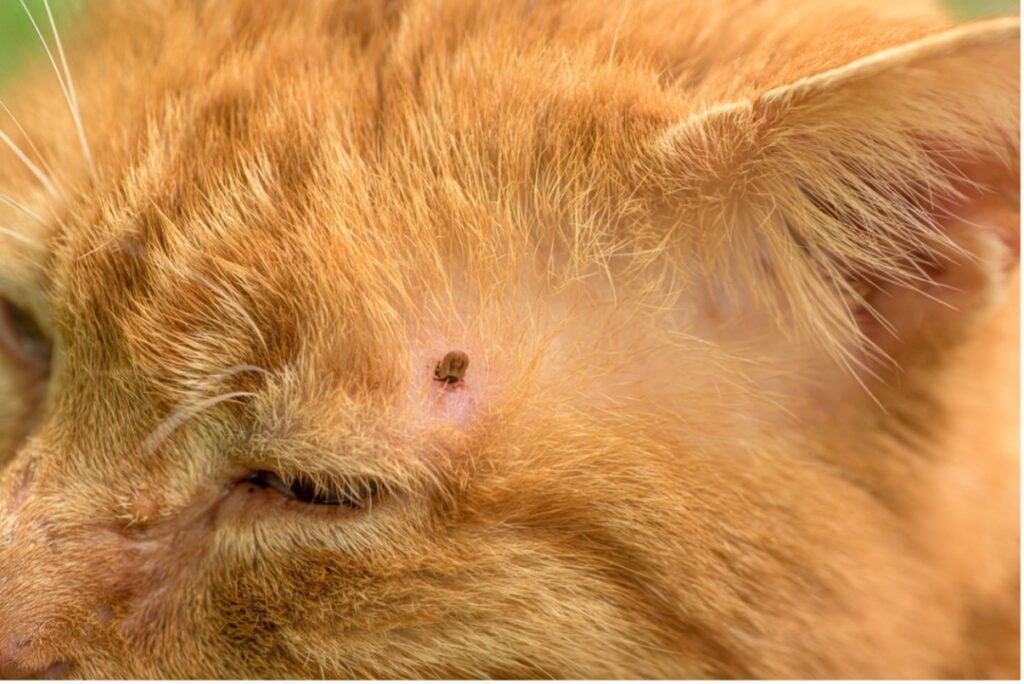
Photo of a cat with a tick
Although at least 15 species of ticks occur in Illinois, only a few of these ticks are likely to be encountered by people and pets:
- American dog tick,
- Lone star tick,
- Blacklegged (deer) tick,
- Brown dog tick and
- Winter tick.
To learn more about the ticks you can encounter in Illinois, please visit the Illinois Department of Health.
Common Signs of Flea and Tick Infestations
Detecting a flea or tick infestation early is critical to effectively treating the problem. Watch for signs indicating fleas or ticks have infested your pet.
- Excessive scratching, biting, or licking.
- Mild to severe redness, irritated skin, or small bumps on your pet’s body.
- Fleas or ticks can sometimes be seen crawling through a pet’s fur.
- Fleas leave behind “flea dirt”. Flea dirt is actually flea poop. It looks like tiny black specks and is made up of digested blood. you tell the difference between dirt and flea dirt? Put some of the dirt on a wet paper towel. If it is flea waste, it will turn orange or a dark reddish-brown color from the digested blood.
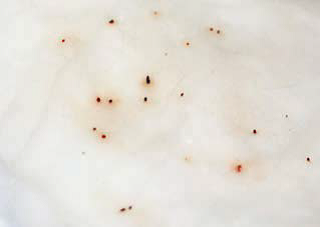
Photo of flea dirt on a wet paper towel
You can find fleas anywhere on a pet’s body. However, fleas prefer areas where the pet cannot easily groom, such as the back of the neck, face, ears, and the base of the tail.
Ticks are most often found around the neck, in the ears, in the folds between the legs and body, and between the toe of dogs. However, they can be found anywhere on the body. Cats may have ticks on their neck or face.
Understanding the Vital Importance of Flea and Tick Prevention
Fleas and ticks are not just nuisances; they can pose serious health risks to pets.
- Allergic reactions: Fleas can cause allergic reactions in animals, leading to excessive itching, hair loss, and skin infections.
- Transmit diseases: Fleas can also transmit diseases such as Bartonella (cat scratch fever) and tapeworms.
- Anemia: Fleas can cause anemia in cats and dogs, especially if the infestation is severe. Fleas feed on blood; when they infest an animal in large numbers, they can cause significant blood loss over time. Anemia can cause symptoms such as weakness, lethargy, and pale gums, and in severe cases, it can be life-threatening if left untreated.
Ticks can transmit a host of diseases, such as:
- Lyme disease
- Ehrlichiosis
- Rocky Mountain Spotted Fever
- Coonhound Paralysis
- Anaplasmosis
Flea and Tick Prevention Methods for Pets
Preventing fleas and ticks from infesting your pets is essential for their well-being. There are several methods you can use to protect your furry friends.
- Topical Treatments
- Oral Medication
Choosing the Right Flea and Tick Prevention Products
With a wide range of flea and tick prevention products available, choosing the right one can be overwhelming. We do not recommend over the counter (OTC) flea and tick preventions. Prescription prevention is the safest and provides the best protection. Consult Dr. McFarland on flea and tick preventative medications. She can guide you on the most effective and appropriate treatment for your pet’s needs. She takes into account your pet’s age, weight, and health condition.
When administering flea and tick preventatives, please follow the instructions provided by the manufacturer to ensure the product’s effectiveness and safety.
If you have a multi-pet household, please treat all pets in the household with prescription flea and tick prevention. Treating all pets in the household is crucial because fleas are extremely adept at spreading. Even if you only notice fleas on one pet, it’s likely that other pets in the household are also affected, even if they’re not showing symptoms yet. Fleas can easily jump from one pet to another. Also, because they lay eggs in various areas of your home treating all pets ensures you are targeting the entire population of fleas in your home and preventing re-infestation.
Removing Ticks from Your Pet’s Body
It is crucial to remove ticks correctly for several reasons:
- Incorrectly removing a tick can regurgitate its stomach contents into the wound, increasing the risk of disease transmission.
- Incorrect removal methods, such as squeezing or twisting the tick, can cause it to break apart, leaving parts of its mouthparts embedded in the skin. These left-behind mouth parts can lead to infection or localized reactions.
- Proper removal techniques minimize discomfort and trauma to the skin. Ticks can be firmly attached, and incorrect removal methods may cause pain or irritation.
- Some pets may be allergic to tick saliva or components of the tick’s body. Proper removal reduces the likelihood of allergic reactions.
- If you damage the skin during improper tick removal, it may become susceptible to secondary bacterial infections. Proper removal reduces this risk.
Please watch the video below from PetMD on How to Remove a Tick from Your Pet. Just click on the picture below to watch.
Flea and Tick Prevention – Maintaining a Pest-free Environment
Preventing fleas and ticks from infesting your pets goes beyond just treating them. Maintaining a flea and tick-free environment is equally important to prevent re-infestation.
- Groom your pets using a flea comb. You can learn from PetMD How to Use a Flea Comb on a Cat and How to Use a Flea Comb for Dogs.
- Vacuuming helps control fleas and ticks by physically removing adult insects, disrupting their life cycle by eliminating eggs and larvae deep within carpets and upholstery, reducing suitable habitats for breeding, and capturing pests in vacuum bags or canisters.
- It is also essential to wash your pet’s bedding and any other fabric items they come into contact with.
- Keeping your outdoor areas well-maintained, such as mowing the lawn and removing debris, can reduce the chances of fleas and ticks thriving in your yard.
- Check your pets for ticks daily, especially after they spend time outdoors.
- If you find a tick on your pet, remove it right away.
- Flea traps, like the Victor Flea Trap, can help reduce flea infestations. They work by attracting fleas to a source of heat, usually a low-wattage light bulb that mimics the heat of a warm-blooded animal. However, they will not get rid of fleas on your pet.
Conclusion for Flea and Tick Prevention
Safeguarding your pets against fleas and ticks is vital, particularly in Illinois, where these parasites thrive. By understanding the life cycles of fleas and ticks, recognizing common signs of infestations, and appreciating the importance of prevention, you can significantly mitigate the health risks posed to your beloved companions. Remember, consulting with a veterinarian like Dr. McFarland and staying informed about effective prevention methods are crucial to ensuring your pets lead a flea and tick-free life. Let’s keep your furry friends protected and enjoy the outdoors without worry! Contact us today!
Warm Regards,
Dr. Janelle McFarland & Team
